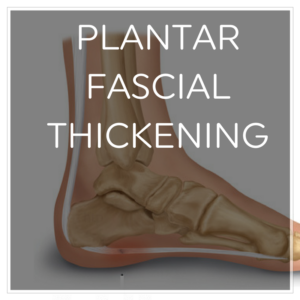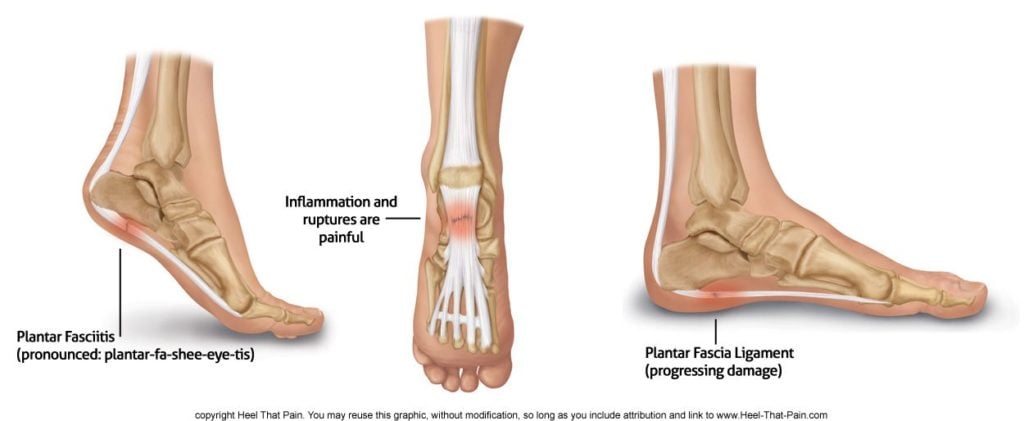 You may have heard that the thickness of your plantar fascia ligament is related to whether or not you have a condition called Plantar Fasciitis.
You may have heard that the thickness of your plantar fascia ligament is related to whether or not you have a condition called Plantar Fasciitis.
But what exactly does that mean? How thick is the average plantar fascia ligament? Why does the ligament get thicker in response to Plantar Fasciitis? How will you know if your plantar fascia is thicker than normal? And what can you do about all of it?
This blog post will cover everything you need to know about plantar fascial thickening.
Normal Plantar Fascia Vs. Thick Plantar Fascia
Just how thick is too thick? Several studies have shown that a healthy plantar fascia ligament runs between 2-4 mm thick in about 90% of people. Women usually have a thinner plantar fascia ligament than men (which may be another reason that women are more likely than men to get plantar fasciitis in the first place!)
Some outliers who don’t suffer from plantar fasciitis may have a plantar fascia ligament as thick as 5 mm. However, numerous studies have shown that for the most part, when the arch of the foot is thicker than 4 mm, there’s a very strong correlation with Plantar Fasciitis.
A study by Dr. Karabay MD, Dr. Toros MD, and Dr. Hurel MD, showed that individuals with heel pain had a plantar fascia thickness measuring an average of 4.79 mm.
Don’t worry: A thick arch doesn’t cause Plantar Fasciitis. It’s just a strong indicator that Plantar Fasciitis is present!
What Is Plantar Fascial Thickening, and Why Does It Happen?

A thicker plantar fascia ligament often goes hand in hand (well, foot in foot) with a diagnosis of Plantar Fasciitis for a couple of reasons:
- Wear and Tear: Plantar fasciitis is caused by wear and tear, trauma, tiny injuries, or overuse of the plantar fascia ligament. A healthy arch distributes weight and absorbs impact sort of like a spring. But with enough trauma, overuse, and injury that spring will collapse–and the feet will flatten. Research from Chang Gung Memorial Hospital has shown that flat feet are related to plantar fascial thickening. Some experts speculate that this tissue thickening happens for the same reason a callus or bunion develops–too much use, pressure, or damage.
- Scar Tissue: Scar tissue can be another reason why the plantar fascia ligament might be thicker than usual. Over time, as the body attempts to support and heal the damaged fascia, tiny lesions and scar tissue can build up, adding extra bulk.
- Swelling: Inflammation and swelling in the area may lead to a thicker plantar fascia ligament.
Identifying a Thickened Plantar Fascia
MRI or ultrasound imaging are two of the most common tools doctors will use to see if the plantar fascia is thickening. These tools show a clear picture of soft tissues in the foot including muscles, ligaments, and tendons.
MRI and ultrasound can also help rule out stress fractures, as well as pinpoint erosion of the fatty heel pad (another telltale sign of Plantar Fasciitis) and heel spurs. Identifying a thickened plantar fascia can help your doctor confirm a diagnosis of plantar fasciitis, since this is one of the most reliable indicators of the condition.
How Can You Prevent Plantar Fascial Thickening?
The best way to prevent plantar fascial thickening is to keep the arch of your foot healthy, supported, and rested.
- Try to avoid long periods of standing when possible
- If your feet or heels hurt or look red and swollen, ice them to bring down the pain and inflammation
- Maintain a healthy body weight when possible, to avoid putting excess strain on your arch
- Wear high-quality orthotic insoles to cushion and support your arches when standing or walking
- Stretch your feet, ankles, and legs to improve strength and flexibility in your arch and supporting muscles and ligaments
Most people don’t have any idea they have a thickened plantar fascia ligament–until heel pain strikes. Thankfully, with easy at-home preventative treatments like these, you can maintain your arch health–and avoid plantar fascial thickening!




What can I do since my fascia is one centimeter I had an MRI and that was the diagnosis
There going to operate on my plantar fasciitis,but dr said it could work and could not work.I’ve had it now over a year.down the same leg very bad pain at the side and all in the knee.